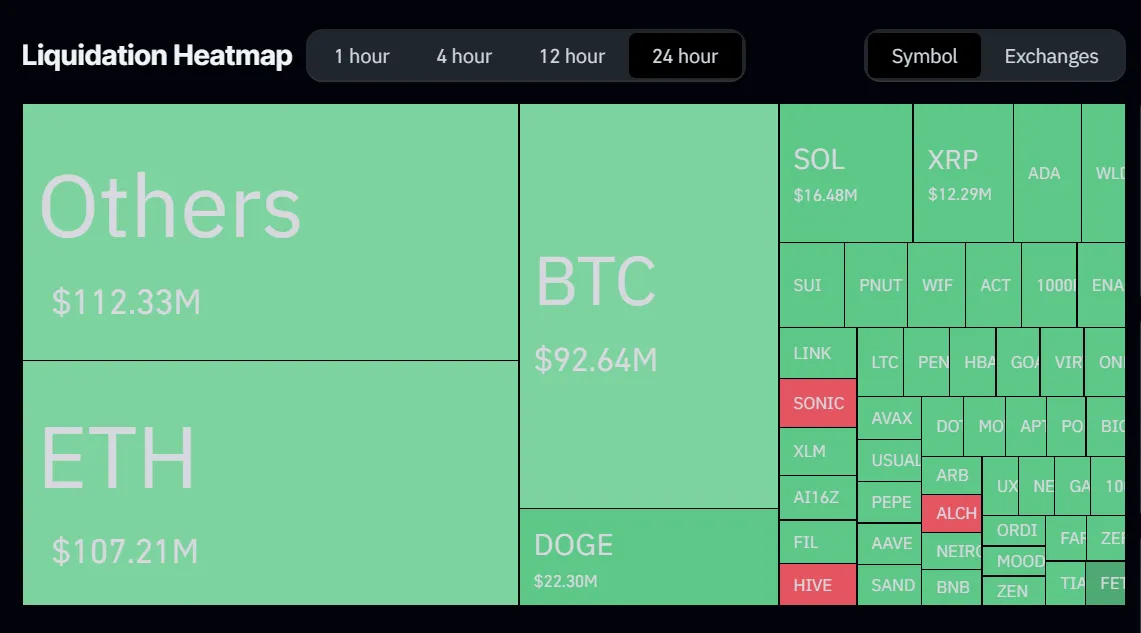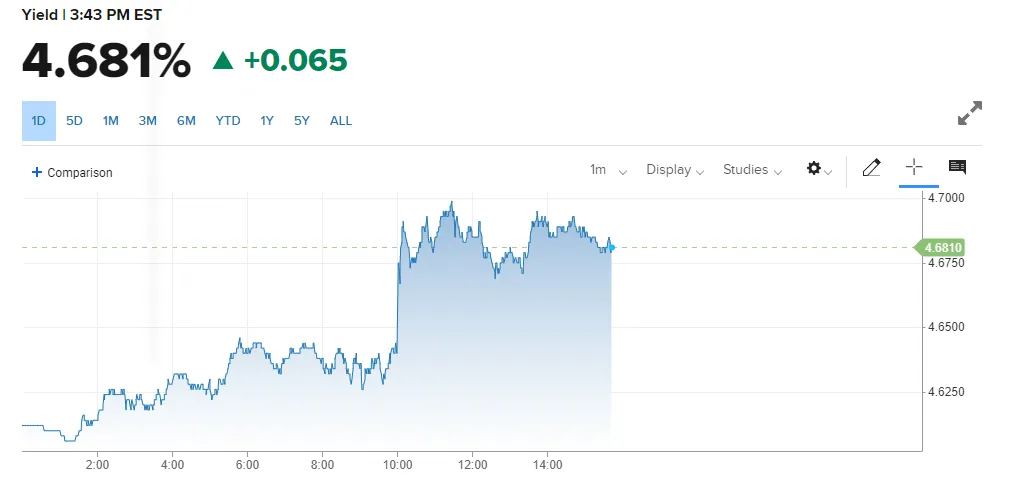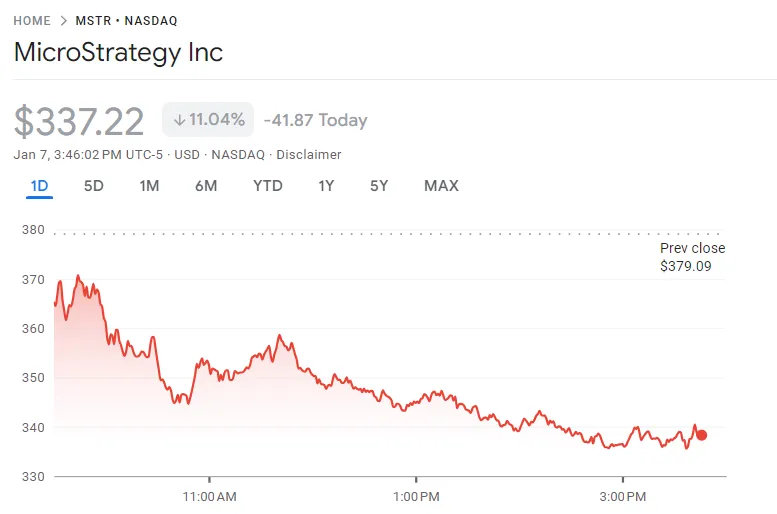| COINOTAG recommends • Exchange signup |
| 💹 Trade with pro tools |
| Fast execution, robust charts, clean risk controls. |
| 👉 Open account → |
| COINOTAG recommends • Exchange signup |
| 🚀 Smooth orders, clear control |
| Advanced order types and market depth in one view. |
| 👉 Create account → |
| COINOTAG recommends • Exchange signup |
| 📈 Clarity in volatile markets |
| Plan entries & exits, manage positions with discipline. |
| 👉 Sign up → |
| COINOTAG recommends • Exchange signup |
| ⚡ Speed, depth, reliability |
| Execute confidently when timing matters. |
| 👉 Open account → |
| COINOTAG recommends • Exchange signup |
| 🧭 A focused workflow for traders |
| Alerts, watchlists, and a repeatable process. |
| 👉 Get started → |
| COINOTAG recommends • Exchange signup |
| ✅ Data‑driven decisions |
| Focus on process—not noise. |
| 👉 Sign up → |
-
As market turbulence unfolds, over $480 million in crypto liquidations have occurred, forced by significant price drops of Bitcoin and Ethereum.
-
The recent fluctuations are attributed to climbing US Treasury yields and robust labor market statistics, increasing pressure on cryptocurrencies.
-
According to market analysts, “Liquidations signal a potential shift in market dynamics, where traders must adapt to a changing landscape,” reflecting sentiments from the COINOTAG source.
The crypto market faces significant setbacks as liquidations ascend over $480 million amid pressures from economic data and market volatility.
Sudden Crypto Liquidations Trigger a Market Pullback
The crypto market has experienced a substantial decline in market capitalization, dropping by 7% as Bitcoin plummeted over 5% and Ethereum nearly 8%. The largest liquidation event transpired on Binance, commanding significant attention from analysts.

The sudden market sell-off coincided with a notable uptick in the 10-year US Treasury yield, which surged amid reports from the Institute for Supply Management indicating unexpected growth in the US services sector for December. This backdrop has intensified apprehensions regarding persistent inflationary pressures that typically weigh heavily on risk assets like cryptocurrencies.
| COINOTAG recommends • Professional traders group |
| 💎 Join a professional trading community |
| Work with senior traders, research‑backed setups, and risk‑first frameworks. |
| 👉 Join the group → |
| COINOTAG recommends • Professional traders group |
| 📊 Transparent performance, real process |
| Spot strategies with documented months of triple‑digit runs during strong trends; futures plans use defined R:R and sizing. |
| 👉 Get access → |
| COINOTAG recommends • Professional traders group |
| 🧭 Research → Plan → Execute |
| Daily levels, watchlists, and post‑trade reviews to build consistency. |
| 👉 Join now → |
| COINOTAG recommends • Professional traders group |
| 🛡️ Risk comes first |
| Sizing methods, invalidation rules, and R‑multiples baked into every plan. |
| 👉 Start today → |
| COINOTAG recommends • Professional traders group |
| 🧠 Learn the “why” behind each trade |
| Live breakdowns, playbooks, and framework‑first education. |
| 👉 Join the group → |
| COINOTAG recommends • Professional traders group |
| 🚀 Insider • APEX • INNER CIRCLE |
| Choose the depth you need—tools, coaching, and member rooms. |
| 👉 Explore tiers → |

Compounding these issues, the market has seen a dramatic decrease in open interest, with Bitcoin and Ethereum both shedding over $1 billion, illustrating considerable deleveraging within the trading landscape.
| COINOTAG recommends • Exchange signup |
| 📈 Clear interface, precise orders |
| Sharp entries & exits with actionable alerts. |
| 👉 Create free account → |
| COINOTAG recommends • Exchange signup |
| 🧠 Smarter tools. Better decisions. |
| Depth analytics and risk features in one view. |
| 👉 Sign up → |
| COINOTAG recommends • Exchange signup |
| 🎯 Take control of entries & exits |
| Set alerts, define stops, execute consistently. |
| 👉 Open account → |
| COINOTAG recommends • Exchange signup |
| 🛠️ From idea to execution |
| Turn setups into plans with practical order types. |
| 👉 Join now → |
| COINOTAG recommends • Exchange signup |
| 📋 Trade your plan |
| Watchlists and routing that support focus. |
| 👉 Get started → |
| COINOTAG recommends • Exchange signup |
| 📊 Precision without the noise |
| Data‑first workflows for active traders. |
| 👉 Sign up → |
“Since yesterday, approximately $1.6 billion in Bitcoin open interest is lost, with Ethereum enduring a $1 billion reduction. The market seems choppy, particularly at this start of the year,” noted popular trader Daan on X (formerly Twitter).
Despite this volatility, some analysts remain wary. They point to the liquidations as a potential precursor to Bitcoin testing a crucial support level at $93,000, which could initiate a bearish trend.
| COINOTAG recommends • Traders club |
| ⚡ Futures with discipline |
| Defined R:R, pre‑set invalidation, execution checklists. |
| 👉 Join the club → |
| COINOTAG recommends • Traders club |
| 🎯 Spot strategies that compound |
| Momentum & accumulation frameworks managed with clear risk. |
| 👉 Get access → |
| COINOTAG recommends • Traders club |
| 🏛️ APEX tier for serious traders |
| Deep dives, analyst Q&A, and accountability sprints. |
| 👉 Explore APEX → |
| COINOTAG recommends • Traders club |
| 📈 Real‑time market structure |
| Key levels, liquidity zones, and actionable context. |
| 👉 Join now → |
| COINOTAG recommends • Traders club |
| 🔔 Smart alerts, not noise |
| Context‑rich notifications tied to plans and risk—never hype. |
| 👉 Get access → |
| COINOTAG recommends • Traders club |
| 🤝 Peer review & coaching |
| Hands‑on feedback that sharpens execution and risk control. |
| 👉 Join the club → |
Trader Jacob King suggested, “Bitcoin is echoing an 8-year resistance pattern. Each rejection at this significant trendline has triggered severe downturns; expect substantial market corrections ahead.” However, others like Rekt Capital project that these liquidations might herald the commencement of a new bullish cycle, setting the stage for an anticipated parabolic price rise before the next bear market expected in 2026.
Economic Data and Federal Reserve Policy Impact
Today’s labor market figures further complicate the situation. The latest JOLTs report showed a surprising number of job openings at 8.098 million, exceeding the expected 7.70 million. Such robust job data could lead the Federal Reserve to adopt a more hawkish stance, prolonging elevated interest rates which historically exert downward pressure on cryptocurrencies.
Recently, Fed officials indicated a reduction in interest rates may occur but hinted at a more cautious approach in future adjustments for 2025.
Amid these developments, the volatility in the crypto market has had a tangible impact on related equities. Notably, MicroStrategy’s stock (MSTR) saw a decline of 10%, aligning it closely with the overall market downturn.
| COINOTAG recommends • Exchange signup |
| 📈 Clear control for futures |
| Sizing, stops, and scenario planning tools. |
| 👉 Open futures account → |
| COINOTAG recommends • Exchange signup |
| 🧩 Structure your futures trades |
| Define entries & exits with advanced orders. |
| 👉 Sign up → |
| COINOTAG recommends • Exchange signup |
| 🛡️ Control volatility |
| Automate alerts and manage positions with discipline. |
| 👉 Get started → |
| COINOTAG recommends • Exchange signup |
| ⚙️ Execution you can rely on |
| Fast routing and meaningful depth insights. |
| 👉 Create account → |
| COINOTAG recommends • Exchange signup |
| 📒 Plan. Execute. Review. |
| Frameworks for consistent decision‑making. |
| 👉 Join now → |
| COINOTAG recommends • Exchange signup |
| 🧩 Choose clarity over complexity |
| Actionable, pro‑grade tools—no fluff. |
| 👉 Open account → |

MicroStrategy has been actively acquiring Bitcoin, including its inaugural purchase for 2025 just yesterday, while Marathon Digital Holdings (MARA), a key Bitcoin miner, also experienced a 5% decrease in stock price.
| COINOTAG recommends • Members‑only research |
| 📌 Curated setups, clearly explained |
| Entry, invalidation, targets, and R:R defined before execution. |
| 👉 Get access → |
| COINOTAG recommends • Members‑only research |
| 🧠 Data‑led decision making |
| Technical + flow + context synthesized into actionable plans. |
| 👉 Join now → |
| COINOTAG recommends • Members‑only research |
| 🧱 Consistency over hype |
| Repeatable rules, realistic expectations, and a calmer mindset. |
| 👉 Get access → |
| COINOTAG recommends • Members‑only research |
| 🕒 Patience is an edge |
| Wait for confirmation and manage risk with checklists. |
| 👉 Join now → |
| COINOTAG recommends • Members‑only research |
| 💼 Professional mentorship |
| Guidance from seasoned traders and structured feedback loops. |
| 👉 Get access → |
| COINOTAG recommends • Members‑only research |
| 🧮 Track • Review • Improve |
| Documented PnL tracking and post‑mortems to accelerate learning. |
| 👉 Join now → |
Conversely, not all cryptocurrencies succumbed to today’s pressures. The Bitget token (BGB) showcased resilience by gaining over 4%, contributing to a January rally exceeding 10%. This behavior underscores the persistent diversity within the crypto market, where certain assets can defy broader trends.
Conclusion
The recent surge in liquidations and the associated market volatility underline the fragility of the current crypto landscape. As participants acclimate to changing economic indicators and Federal Reserve policy implications, the future trajectory of assets like Bitcoin and Ethereum remains uncertain. Staying informed and vigilant is crucial as traders navigate these rocky waters and adapt to emerging market dynamics.
| COINOTAG recommends • Exchange signup |
| 🎯 Focus on process over noise |
| Plan trades, size positions, execute consistently. |
| 👉 Sign up → |
| COINOTAG recommends • Exchange signup |
| 🛠️ Simplify execution |
| Keep decisions clear with practical controls. |
| 👉 Get started → |
| COINOTAG recommends • Exchange signup |
| 📊 Make data your edge |
| Use depth and alerts to avoid guesswork. |
| 👉 Open account → |
| COINOTAG recommends • Exchange signup |
| 🧭 Be prepared, not reactive |
| Turn setups into rules before you trade. |
| 👉 Create account → |
| COINOTAG recommends • Exchange signup |
| ✍️ Plan first, then act |
| Entries, exits, and reviews that fit your routine. |
| 👉 Join now → |
| COINOTAG recommends • Exchange signup |
| 🧩 Consistency beats intensity |
| Small, repeatable steps win the long run. |
| 👉 Sign up → |
| COINOTAG recommends • Members‑only research |
| 📌 Curated setups, clearly explained |
| Entry, invalidation, targets, and R:R defined before execution. |
| 👉 Get access → |
| COINOTAG recommends • Members‑only research |
| 🧠 Data‑led decision making |
| Technical + flow + context synthesized into actionable plans. |
| 👉 Join now → |
| COINOTAG recommends • Members‑only research |
| 🧱 Consistency over hype |
| Repeatable rules, realistic expectations, and a calmer mindset. |
| 👉 Get access → |
| COINOTAG recommends • Members‑only research |
| 🕒 Patience is an edge |
| Wait for confirmation and manage risk with checklists. |
| 👉 Join now → |
| COINOTAG recommends • Members‑only research |
| 💼 Professional mentorship |
| Guidance from seasoned traders and structured feedback loops. |
| 👉 Get access → |
| COINOTAG recommends • Members‑only research |
| 🧮 Track • Review • Improve |
| Documented PnL tracking and post‑mortems to accelerate learning. |
| 👉 Join now → |










